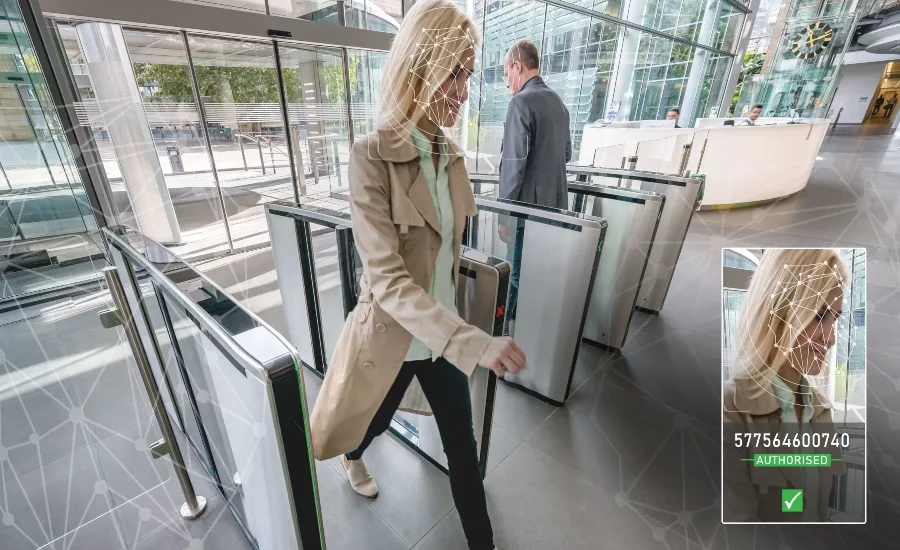The future of AI integration with secured entrances
Integrated solutions using advanced analytics and artificial intelligence (AI) bring expanded functionality and enhanced security to swinging doors and turnstiles

Security technology headlines this past decade have often been dominated by the flashy expansion of video-related devices that have evolved with advanced capabilities thanks to enhanced analytics. However, over the past year, due in part to the continued pandemic crisis, the once conventional access control sector is grabbing its own share of notoriety. Integrated systems are tapping into advancements in artificial intelligence (AI)-driven solutions that are accelerating development of cloud integration platforms and a growing inventory of mobile access control devices, touchless and biometric options.
While AI is becoming an integral part of business operations in myriad market segments around the globe, security applications have been slower to adopt it into the mix. However, the added health risks organizations now face from COVID-19 have forced both security solutions providers and users to rethink how AI can help mitigate those risks. There is little argument that AI has the potential to substantially increase the security of exterior and interior entrances as applied in the short term during this crisis. But while AI will be able to help in many security-related tasks, such as discerning people from objects at a facility’s perimeter and interior entrances, detecting attempted piggybacking, spotting and analyzing potentially lethal objects and dangerous people, and more, AI analytics alone cannot take action to prevent unauthorized human entry or deny the entry of dangerous objects.
AI Migration Requires an Integrated Approach
The migration of security technology to the edge and the rapid expansion of security devices in the IoT universe is a growing reality. Systems designers and users face the challenge of learning how AI may practically support entry solutions such as security revolving doors, turnstiles, and swing doors. A disconnect between the objectives of the building owner and building code regulations can further complicate the security blueprint.
There are many security entrances that do not have AI built into their technology. A successful project that integrates intelligence into secured entrances requires a collaborative effort with a third-party solutions provider. Systems integrators are deploying video analytics into a growing number of applications to address use cases such as people and piggybacking detection, dangerous object detection, and facial recognition, among other issues relevant to secured entrances. The increased integration of AI providers with traditional security entrance partners has resulted in improvements in:
- Return on Investment (ROI)
- Speed of entry through the door or lanes
- Ease of use and usability (no badge is needed)
- The use of machine learning to improve algorithms over traditional modeling and correlation approaches
- Integration with additional systems and sensors
Some industry consultants warn that manufacturers’ goals must align with their end users’ needs when it comes to driving the development of embedded solutions with advanced sensors (e.g., cameras, microwave, LIDAR), operational analytics (facial recognition, tracking, object discrimination, pattern recognition), and active response (entry lockout, alert notification) that can be implemented now to detect or prevent unauthorized entry.
“The security entrance must be part of the general building operations design, clearly separated from an architect’s complete authority. Most secured entries are specified in the Construction Specifications Institute MasterFormat Division 28 [Electronic Safety and Security], outside of building design since it is structural and falls under code compliance surrounding emergency egress as well as building capacity and throughput. Therefore, if this [AI] is to work, the rules for design and the merging of Division 28 and Division 8 [Openings] must become refined, practical, and widely accepted,” says consultant Ben Butchko, President and CEO of Butchko, Inc. and a former security engineer with ExxonMobil.
Making a Plan That Works
It is crucial to understand that many security entrances and mantrap portals often combine a number of systems, sensors and requirements in order to effectively mitigate unauthorized entry. Portals, by their nature, prevent tailgating and piggybacking while combining multiple other integrated technologies, such as access control, video surveillance, mechanical hardware, and sensors.
An early example of this integration trend is the addition of cameras located near high-risk portals, which enables managers to tie what took place at an entrance to a corresponding alarm condition such as a forced or jammed (propped) entrance/exit. The enhanced capabilities provided by analytics like facial recognition could be used to determine which individuals might have set off the alarm condition. Analytics and other sensors could count the number of people that move through a portal during rush periods in “open” mode and also determine that a crowd has gathered, and more doors/portals need to be opened to address the burst in demand for ingress or egress.
Salvatore D'Agostino, the CEO of IDmachines, a technology firm that provides a technical automation platform for the lifecycle management of physical security, surveillance systems, and Internet-connected devices, sees the convergence of AI into security spaces, not known for their reliance on analytic data, reshaping the landscape. AI can be used as a proactive step against intrusion at a security entrance like a swing door or turnstile and integrated into the access control and video security systems to provide rich analytics and situational awareness.
“From a design perspective there is an increasing demand, due to COVID-19, for touchless access. In this case, the integration of technologies and the use of machine learning can be leveraged to provide efficient, safe and secure access. Machine learning and AI are well adapted to leveraging data sets and, over time, gaining an understanding of conditions and matching them to access control and individual requirements,” concludes D’Agostino, pointing out that the migration to touchless technology has moved beyond simple access control to building automation devices and even touchless computer login. “The more that physical security systems adopt standard data types, sets and structures (using syslog for logging is a simple example) and the more intelligent these systems become, the more intelligence can be put into the predictive analytics.”
This article originally ran in Security, a twice-monthly security-focused eNewsletter for security end users, brought to you by Security Magazine. Subscribe here.
Looking for a reprint of this article?
From high-res PDFs to custom plaques, order your copy today!








